Recommended Trees
This page lists trees appropriate for planting on private property, and with permission, on public property in Arlington County. The lists have been vetted for trees that are structurally sound if maintained well, and do not contain species known to be invasive. To find a list of trees native to our region, consult our partners with Plant NOVA natives at https://www.plantnovanatives.org/ . To find out whether a species is native to Arlington County, consult the Virginia Digital Plant Atlas
- For planting on County property (along streets, parks and other public areas), refer to our Tree Planting Program.
- If you’re a developer or are performing a large project in Arlington, refer to the Chesapeake Bay Ordinance page. The lists on this page do not necessarily apply to the Chesapeake Bay Ordinance.
- Consult the Virginia Tech Tree database for more detailed information and pictures.
Contact the County Urban Forestry office at urbanforestry@arlingtonva.us for further questions. The lists on this page are subject to change.
Before you select species:
Right tree, right place: Every species of tree has different requirements,. Understand the space in which you are planning for tree planting before finalizing your selection. Work with a qualified professional, or reach out to your local extension agent for assistance.
Arlington County has a Natives Preferred policy for planting on County property, and local native trees are required in Resource Protection Areas, Natural Lands or Natural Resource Conservation Areas
Chesapeake Bay Ordinance credits and spacing:
This spreadsheet serves as Appendix E to the Chesapeake Bay Preservation Ordinance Guidance Manual, with the following credits and spacing requirements:
| Size |
Native |
Non-native |
Min. Spacing |
| Large |
393.75 |
315 |
20 Ft |
| Medium-Large |
312.5 |
250 |
20 Ft |
| Medium |
218.75 |
175 |
15 Ft |
| Small-Medium |
137.5 |
110 |
10 Ft |
| Small |
62.5 |
50 |
10 Ft |
Columnar or dwarf varieties may not receive full canopy credit.
Shade Trees
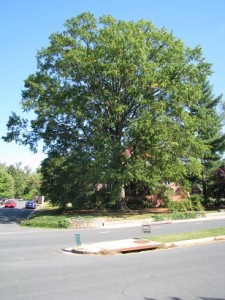
Shade & Maximum Environmental Benefit
Shade trees can significantly alter the microclimate around a home, resulting in a more comfortable environment and significant savings in heating and cooling costs over time. Large shade trees also provide the most significant stormwater and wildlife benefit.
These trees should be planted with the future in mind. Be aware of overhead powerlines or nearby structures when planting these trees.
Shade Tree List(PDF, 180KB)
Small Trees
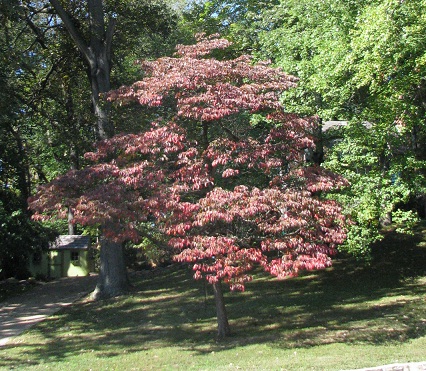
Small Spaces & Accent
A list of trees perfect for accents, ornamental display, or spaces with low soil space. Consider these species when filling out a landscape, or when maintenance budget is limited. Appropriate for planting under most overhead utilities, however, these species have not been reviewed by Dominion Virginia Power, and utility companies maintain the right to prune or trim any trees or vegetation away from their lines.
Small Tree List(PDF, 307KB)
Evergreen Trees
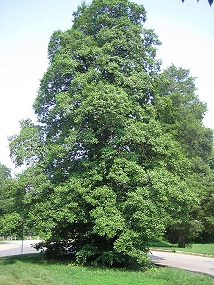
Screening & Shade in the Summer, Wind Breaks in the Winter
Evergreen trees provide great screening, shade in the summer, and wind breaks in the winter. Evergreen trees also provide year-round wildlife food, crucial for survival during the winter.
Some of the larger evergreens should be planted with the future in mind. Be aware of overhead powerlines or nearby structures when planting these trees.
Evergreen Tree List(PDF, 96KB)
Large Street Trees

Recommended trees for planting in restricted space, along streets.
Large street trees can significantly improve the aesthetic and microclimate of our streets, resulting in a more comfortable environment and significant savings in heating and cooling costs over time. Large street trees also provide the most significant stormwater and wildlife benefit.
Large street trees are the most common tree to line Arlington streets, except where overhead lines limit future growth. Be aware of overhead powerlines or nearby structures when planting these trees.
Large Street Trees(PDF, 153KB)
Small Street Trees
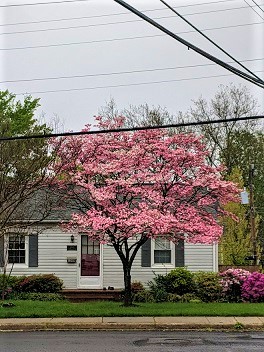
A list of small street trees that may be acceptable to be planted below powerlines
A list of small street trees for street right-of-ways that may be acceptable to be planted below power lines, due to size or stature. These species have not been reviewed by Dominion Virginia Power, and utility companies maintain the right to prune or trim any trees or vegetation away from their lines.
Small Street Trees(PDF, 291KB)
Storm water facility trees and shrubs

Trees that work well in storm water facilities
A list of trees that may be acceptable to be planted in storm water facilities. These species have been reviewed by the Department of Environmental Services and Urban Forestry to survive well in these facilities. Planting trees on this list should be spaced with care, to avoid underground pipes and utilities, and to ensure the proper function of the facility.
Storm water facility trees(PDF, 305KB)
Invasive Trees

Do Not Plant These Trees
Invasive plant species degrade the landscape in several ways. In Arlington, invasive plants negatively impact ecosystem health, green infrastructure and canopy coverage. Due to their ability to outcompete native plants, invasive plants have displaced many native species that provide habitat and forage for wildlife. Additionally, invasive plants can disrupt normal forest succession by inhibiting regeneration of native tree species.
For more information on invasive species, check out our Invasive Plant Program.
Invasive Tree List
Master Tree List
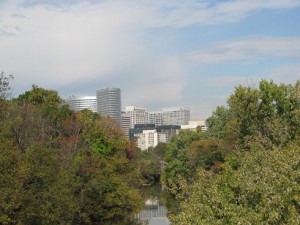
Compilation of All Recommended Trees for Arlington County
A list of trees appropriate for planting in Arlington County. This list has been vetted for trees that are structurally sound if maintained well, and do not pose an ecological risk due to invasion.
Master Tree List(PDF, 238KB) (PDF)
Master Tree List(XLSX, 103KB) (Excel)
Other lists
Other lists for reference. These lists may have more untested species on them, and are not necessarily always appropriate for planting in every situation. Non-native trees should only be used in very limited situations.
(PDF, 1MB)Fruit trees for Arlington County(PDF, 519KB)
Experimental rooftop tree list(XLSX, 31KB)
Non-native trees not on our invasive plant list(PDF, 431KB)
Glossary:
| Genus |
A group of plants marked by common characteristics, like Quercus (Oaks), Acer (Maples), or Cornus (Dogwoods) |
| Species |
An individual type of plant, capable of interbreeding within its designation, like Quercus stellata (Post oak), or Tilia americana (American linden) |
| Common Name |
The common description of a plant, like American Holly, or Tuliptree. A tree can have several common names, which is why latin names are often preferred. |
| Evergreen |
A tree which retains its leaves over the winter. These trees do lose leaves or needles over time, but at a slower rate than deciduous trees |
| Size |
Mature size (usually within 30-50 years, depending on species, but all trees continue to grow). Small trees typically stay under 20 ft tall, medium under 40 ft, and large trees can reach up to 100 ft tall |
| Light needs |
The light requirements for a tree to grow optimally. Trees preferring full sun should be in full sun for at least 6 hours a day, while trees preferring shade can live with less than 3 hours of sunlight a day |
| Moisture preference |
The need for dry, moderate, or wet soils. This can be accomodated through proper irrigation, maintenance and/or design |
| Street Tree |
Trees well suited for planting along roads, or in tree pits, when specified as upright or vase-shaped form for small trees, and limbed up to a safe height, and not obstruct view for traffic. Trees with large fruit can be planted in low density areas |
| Pollution Resistant |
Trees well suited for planting in tough areas with high pollution from both the air, as well as salt spray from the road. These species are often also well-suited for stormwater control facilities. |
| Powerline Compatible |
Species that may be acceptable to be planted below powerlines, due to size or stature. These species have not been reviewed by Dominion Virginia Power, and utility companies maintain the right to prune or trim any trees or vegetation |
| Use in stormwater solutions |
Trees that may be appropriate to be planted in regulated stormwater BMPs. Street tree BMPs not currently permitted |
| Visual Attraction/food source |
Interest from the tree that sets it apart from other trees, or potential food source. Do your research before eating, and confirm your identification. |
| Native range |
Locally native (native to Arlington), regionally native (native to Mid-Atlantic) or non-native (not native to Mid-Atlantic) |
| Shade Tree |
A tree likely to grow to a size where it will cast significant shade on the surrounding environment, reducing energy costs and urban heat island effect. |
| Notes for use/Disease susceptibility |
Notes for specifying this tree, suggested cultivars, and potential pest issues. |
| Minimum Soil Volume |
Minimum soil volumes required to allow the tree to meet its genetic potential size. |
| Chesapeake Bay Preservation Ordinance Size requirement (height or caliper) |
Minimum required height or caliper for a tree to be counted for Chesapeake Bay Preservation Ordinance tree canopy requirements |
| Chesapeake Bay Preservation Ordinance Minimum Spread requirement (Feet) |
Minimum required spread for a tree to be counted for Chesapeake Bay Preservation Ordinance tree canopy requirements |
| Chesapeake Bay Preservation Ordinance Coverage (including native bonus) |
Total coverage given to each species, according to the table below |